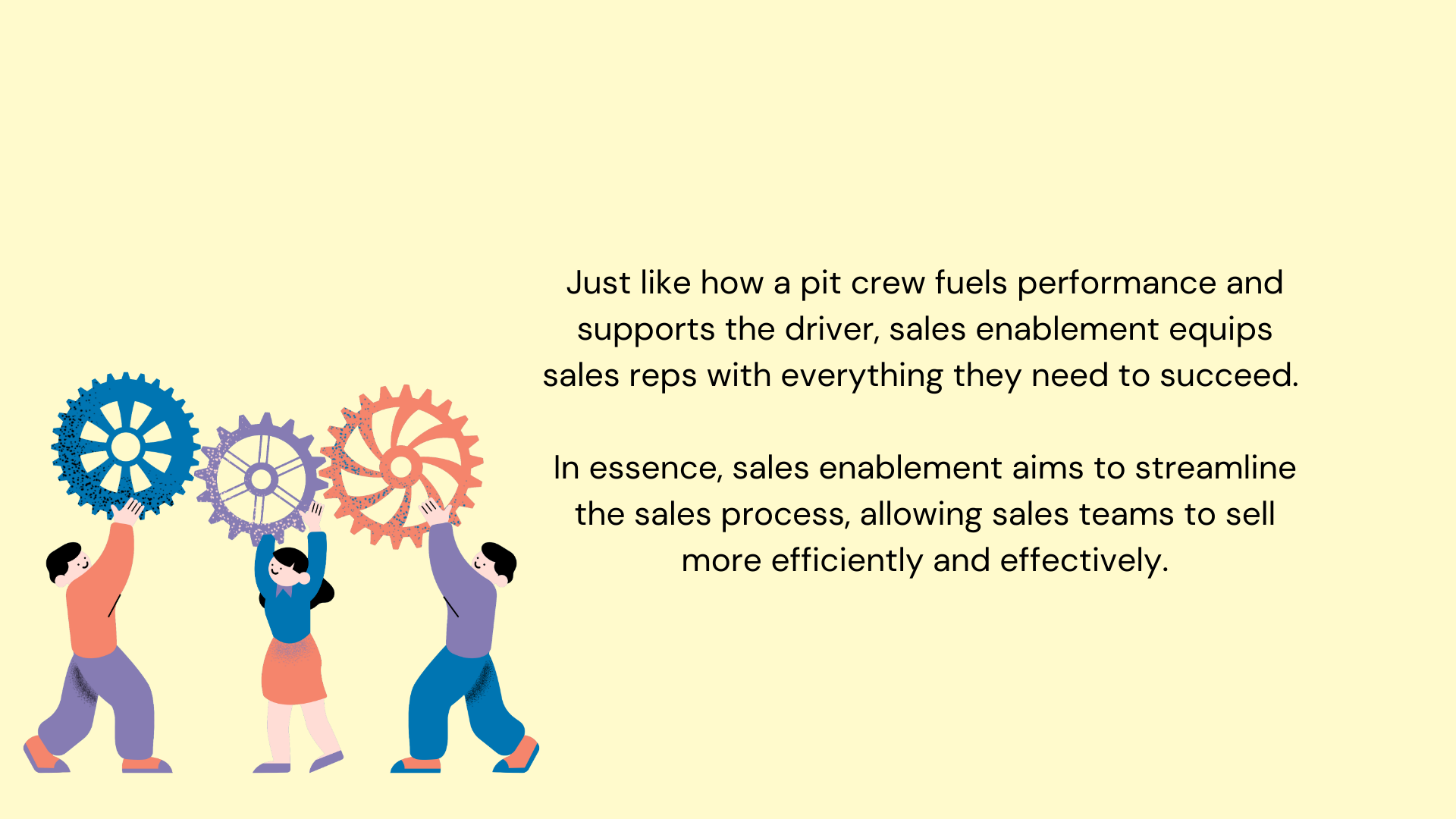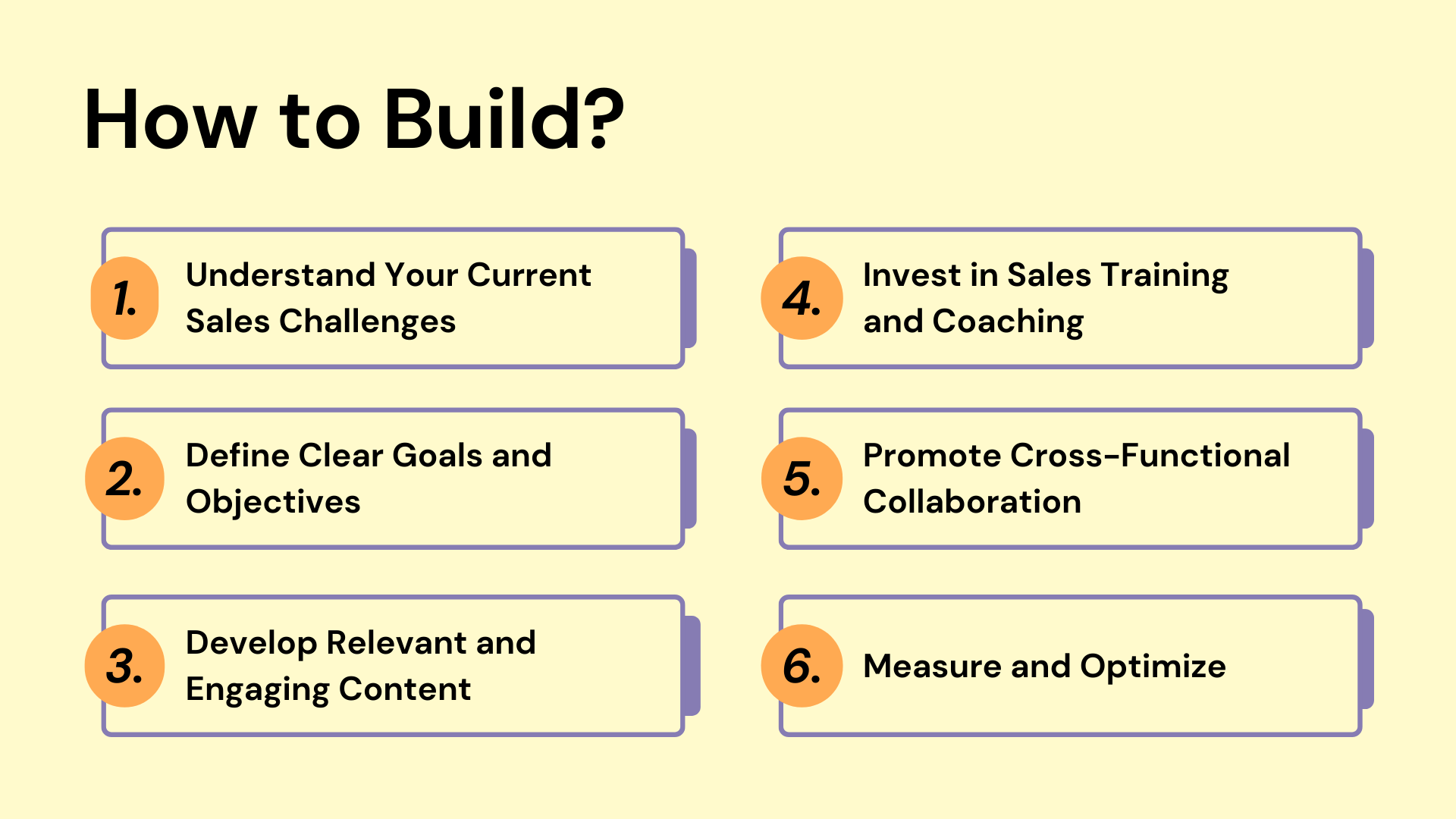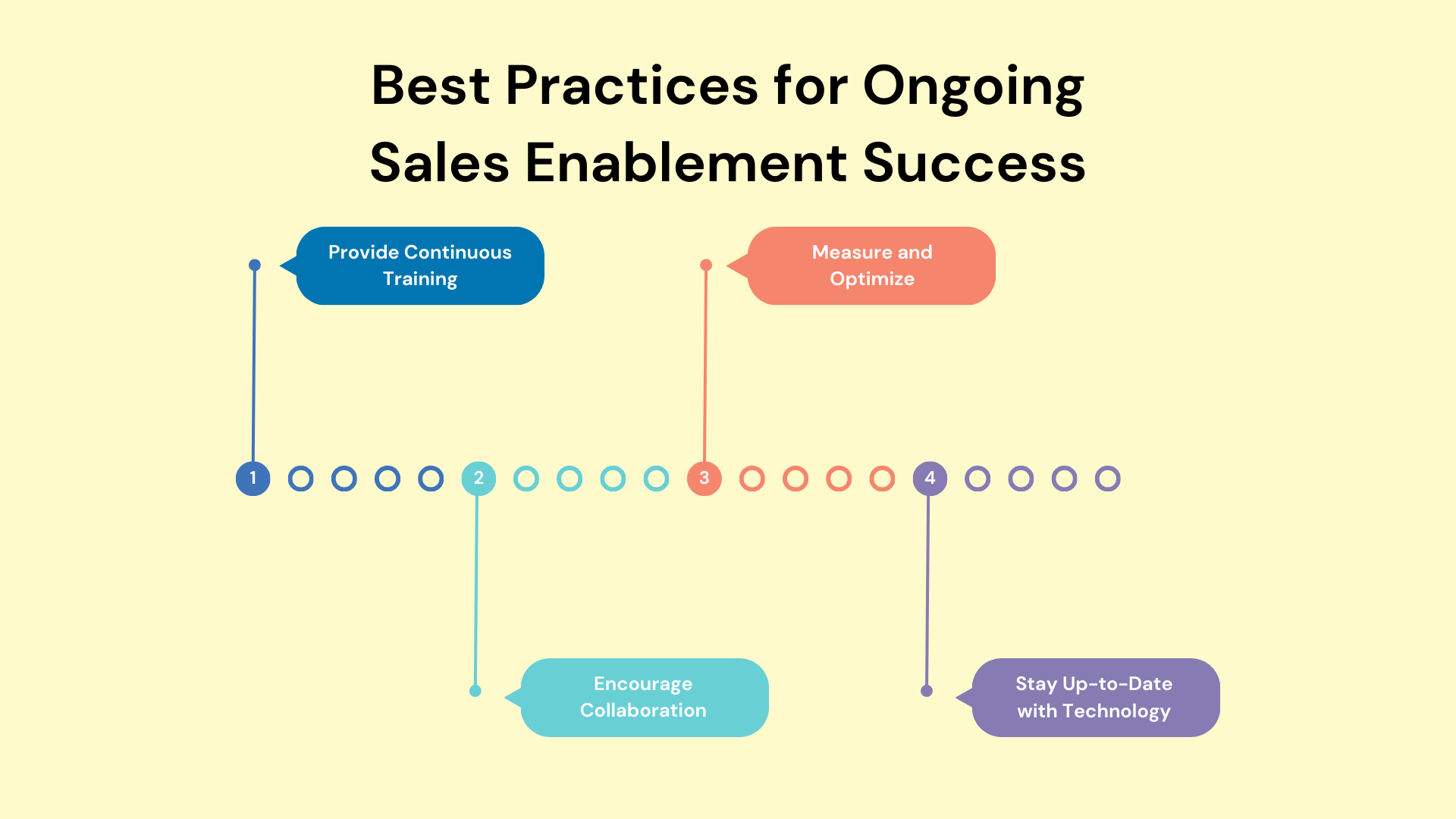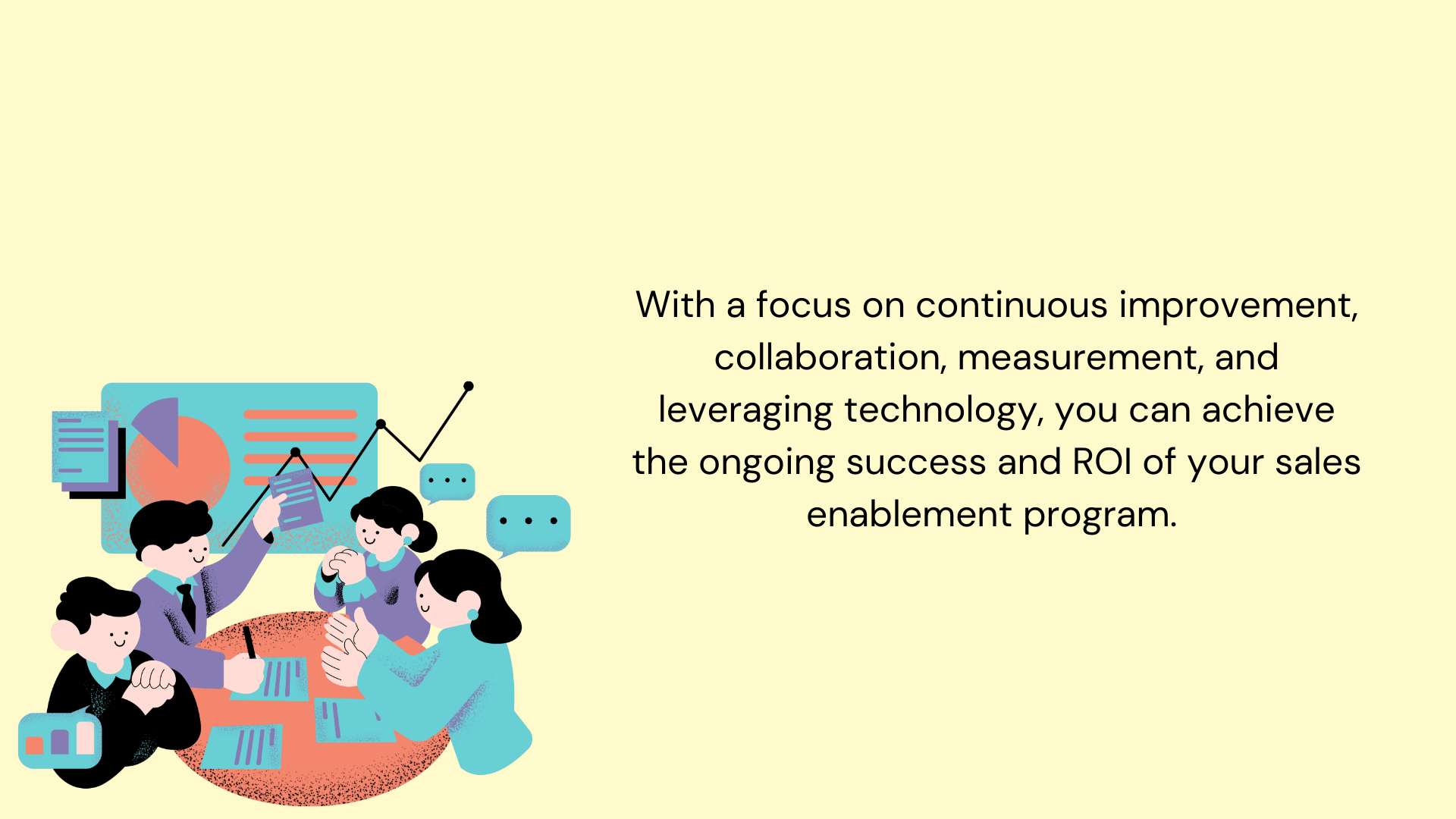Table of Contents:
- What Is Sales Enablement
- The Benefits of Sales Enablement for Your Business
- How to Build a Successful Sales Enablement Program
- Tools for Sales Enablement
- Best Practices for Ongoing Sales Enablement Success
Introduction
As a sales leader, you are constantly challenged to improve sales productivity and close more deals.
Your sales reps are on the front lines interacting with prospects and customers daily, so empowering them with the knowledge, skills, and resources to succeed is critical to meeting your goals.
Sales enablement is the strategic process of providing your sales team with the right information, content, and tools at the right times to drive sales results.
When done well, sales enablement can increase win rates, accelerate the sales cycle, and boost customer retention.
This article will explore what sales enablement is, why it's crucial for sales success, how to implement an effective enablement program, best practices to follow, and essential tools to leverage.
Equipping your reps to have engaging conversations and share targeted content is how you turn your sales team into a deal-closing powerhouse.
With the right sales enablement strategy, you'll gain a competitive advantage and see your numbers soar.
What Is Sales Enablement
Sales enablement refers to empowering your sales team with the knowledge, tools, and resources they need to close more deals.
It bridges the gap between sales and marketing, ensuring a seamless buyer experience by equipping the sales team with the best content, training, and coaching.
To give an analogy, think of sales enablement as the pit crew in a car race. The driver (or the sales rep) is responsible for driving the car (the sales process) around the track (the market) as efficiently and quickly as possible.
But they can't do it alone. They need a pit crew (the sales enablement team) that ensures they have enough fuel (content), that their car is in top shape (sales training), and that they have the best tires for current weather conditions (sales tools, like CRM systems).
When done well, sales enablement leads to higher win rates, larger deal sizes, and improved sales productivity.

The Benefits of Sales Enablement for Your Business
Sales enablement is the process of providing your sales team with the resources and content they need to sell effectively.
When done right, a sales enablement program can have huge benefits for your business.
Improved Sales Performance and Reduced Sales Cycles
Sales enablement empowers your sales reps to have more effective conversations with leads and close deals faster.
By arming them with targeted content, sales tools, and training, reps can have in-depth, consultative discussions with prospects and accelerate the sales cycle.
Boosts Sales Productivity and Consistency
With ready-made presentations, email templates, product guides, and other resources at their fingertips, sales reps don’t have to start from scratch for each new opportunity.
They can spend more time actually selling instead of creating materials.
Sales enablement enables synergy between sales and marketing teams, ensuring consistent messaging and positioning throughout the buying process.
Increased Buyer Engagement
Sales enablement helps align marketing and sales, creating a cohesive customer experience.
When marketing provides content and tools tailored to key stages of the buyer’s journey, sales reps can easily continue and build on the relationship at each touchpoint.
This results in a smooth transition from lead to customer.
Informed Decision-Making
Sales enablement tools provide insightful analytics, helping managers make data-driven decisions, and improving overall sales performance.
Higher Revenue
By capitalizing on efficiencies, nurturing talent, and improving alignment, sales enablement ultimately leads to increased sales and higher revenue for the organization.
How to Build a Successful Sales Enablement Program

To succeed at sales enablement, you must provide your team with in-depth information about your products and services, your key differentiators, common customer pain points, and competitor details.
Equip them with sales collateral like guidelines, case studies, and proposal templates. Give them access to tools for prospecting, managing sales pipelines, and gaining customer insights.
Understand Your Current Sales Challenges
The first step in designing an efficient program is identifying the challenges hindering your sales performance.
These could encompass training gaps, inadequate tools, lack of quality content, or inefficient sales processes.
Define Clear Goals and Objectives
Clarity on what you hope to achieve with your sales enablement program is essential.
Whether it's enhancing sales productivity, improving conversion rates, or shortening the sales cycle, your goals should steer the program's direction.
Develop Relevant and Engaging Content
Content is a critical element of sales enablement. Work with your marketing team to create and aggregate content that resonates with your customers and aligns with their journey stages.
Invest in Sales Training and Coaching
Equip your sales team with the skills and knowledge to succeed. This includes product knowledge, sales techniques, and customer handling skills.
Regular training interventions and coaching sessions should form an integral part of your program.
Leverage Technology
Utilizing sales enablement technology can streamline the sales process. Be it CRM systems, content management tools, or data analytics platforms, the right technology can foster efficiency and enhance performance.
When developing your strategy, consider your ideal customer profiles to determine what types of content and tools will be most useful for engaging your target audiences.
Survey your sales team to assess their needs and identify any knowledge or resource gaps.
An effective sales enablement program requires selecting tools for content creation, storage, and distribution. Some recommended options include:
- A content management system to store and organize sales collateral.
- Digital distribution tools to share content with your sales reps.
- Presentation creation software for developing visual aids.
- A social media management platform to assist with social selling.
Promote Cross-Functional Collaboration
Alignment between sales, marketing, product, and customer support teams is vital. Collaborative efforts lead to consistent messaging, a smoother sales process, and a unified approach to achieving business goals.
Measure and Optimize
Track the success of your sales enablement program using defined KPIs. Regular assessments coupled with necessary adjustments keep your sales enablement program on the path to success.
Consider these metrics:
- Sales Cycle Length: A decrease in sales cycle length could indicate an effective strategy.
- Sales Training Completion Rates: Low completion rates may indicate a need for more engaging or relevant training content.
- Content Usage: Quantifying how frequently and effectively salespersons use provided content when interacting with prospects can provide deeper insights into the content's relevance and utility.
- Conversion Rates: A high conversion rate signifies effective sales processes and enables tactics.
- Deal Size or Average Contract Value: An increase in the average deal size could be an indicator of effective sales enablement strategies.
- Win Rate: The ratio of deals won to total deals pursued over a period. An increased win rate often signals that a sales enablement program is proving beneficial.
- Time Spent Selling: The amount of time sales reps spend on direct selling activities. Sales enablement tools should ideally increase this metric by reducing time spent on non-selling activities.
- Quota Attainment: The percentage of sales reps meeting or exceeding their sales quota. A higher rate can indicate successful sales enablement strategies.

Continually revisiting your enablement strategy and optimizing your content and technology based on sales team feedback is key to long-term success.
Tools for Sales Enablement
To enable your sales team and empower them to close more deals, certain tools and strategies are essential.
With these assets at their fingertips, your sales reps can have more strategic conversations with leads and close deals faster.
They'll spend less time searching for resources and more time selling. Sales enablement also boosts morale since reps feel fully supported.
Customer Relationship Management (CRM) System
A CRM system is vital for managing customer data and interactions. An effective CRM helps your team track prospects, monitor deal progress, log communications, and gain insights into opportunities.
Look for a CRM that integrates with your other sales tools and is easy for reps to use on a daily basis.
Sales Enablement Platform
A dedicated sales enablement platform provides your team with resources to improve productivity and performance. It should offer features like:
- A content library with collateral, presentations, objection handlers, and product info.
- Learning and training modules to strengthen product knowledge and sales skills.
- Analytics to gain visibility into content and tool usage, identify gaps, and optimize the platform.
Tools for Prospecting and Outreach
With tools for email outreach, calling, and social selling, your reps have more ways to engage prospects and move them through the funnel. Options include:
- Email marketing and campaign automation platforms.
- Calling and voicemail drop tools.
- LinkedIn Sales Navigator for social prospecting.
These tools streamline outreach, provide more touchpoints, and allow reps to personalize messaging for the best results.
Coaching and Development Tools
Continuous coaching and development are key to enabling your team. Hold regular one-on-one coaching sessions, encourage peer feedback, and provide learning opportunities.
Sales managers should coach reps on skills like effective discovery, presentation delivery, objection handling, and closing techniques.
Ongoing learning and coaching keep reps motivated and performing at their best. You can also use tools like MindTickle or Seismic to aid in the development of sales teams, from successfully onboarding new hires to honing the skills of seasoned reps.
Content Management Tools
Creating, organizing, and delivering sales content effectively is possible with content management tools.
A platform like Sanka offers content analytics, optimization, personalization, and distribution capabilities.
From creating and publishing marketing campaigns to sending bulk DMs on Twitter, Sanka offers innovative tools designed to elevate your sales and business development efforts.
Trusted by industry leaders, our services guarantee efficient operations and tangible results.
Best Practices for Ongoing Sales Enablement Success

To achieve ongoing success with your sales enablement program, follow these best practices:
Provide Continuous Training
Effective sales enablement requires continuous investment in your team through ongoing training and coaching.
Schedule regular refreshers on products, services, competitive positioning, and sales skills. Offer onboarding programs for new hires to get them up to speed quickly.
Provide opportunities for peer-to-peer learning and mentorship. Continuous learning and development will keep your sales team motivated and performing at their best.
Encourage Collaboration
Create opportunities for your sales team to collaborate and share knowledge. Set up channels for them to connect, ask questions, and exchange insights.
They can share experiences, discuss challenges, and pass along tips for overcoming objections or navigating deals.
Collaboration builds teamwork and helps spread best practices across your organization.
Measure and Optimize
Analyze key metrics like win rates, deal velocity, and customer retention to measure the success and impact of your sales enablement program.
Look for areas of improvement and opportunities to optimize. Make data-driven decisions to refine content, adjust training, or redesign processes based on the metrics that matter most to your business.
Measuring performance and making continuous optimizations will help maximize your return on investment in sales enablement.
Stay Up-to-Date with Technology
Leverage the latest sales enablement technologies and tools to improve efficiency and productivity.
Solutions for content management, training delivery, customer relationship management, and sales engagement can streamline processes and provide actionable insights.
However, technology should complement and not replace the human element. Strike a balance between high-tech and high-touch for the most effective sales enablement.

By empowering your sales team with the knowledge and skills to excel, you'll gain a competitive advantage and close more deals.
Conclusion
In summary, sales enablement is critical to empowering your sales team and driving revenue growth.
By providing your reps with the knowledge, skills, and tools they need to have meaningful conversations with prospects, you equip them to close more deals.
With a comprehensive sales enablement strategy focused on education, content, and technology, you can transform your sales organization into a high-performing machine.
Success comes from understanding your customer, enabling your team, and measuring the impact to continuously optimize.
Make sales enablement a priority at your company and watch your numbers soar.







